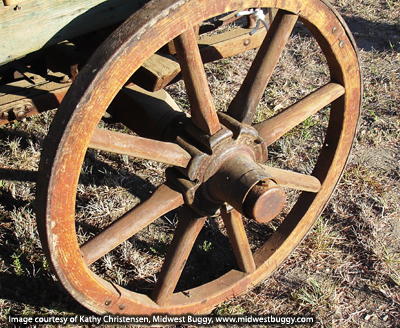I receive a lot of emails and questionsin the course of a year. While I’m ableto assist a number of folks, not all inquiries are easily answered. Such was the case when Kathy Christensen of Midwest Buggy in Lockney, Texas sent mea challenging question; a real stumper and head scratcher. In her travels, Kathy had come across a wagongear with very distinctive cast metal hubs. The hubs were large and heavy. Itwas easy to see they weren’t of a Sarven, Warner, or Archibald design. Just what they were, though, remained amystery.
Like a lot of these forgotten parts of yesterday, it was a mystery that took some time to crack. Nonetheless, whilesome people ‘never forget a face,’ I rarely forget a design. It’s a personality trait that has helped me closethe case on a number of questions over the years. When it comes to early wagons and westernvehicles, my mind seems to hold onto what it has seen and plays some type of subliminalgame of comparison as new information is accumulated. Don’t get me wrong, not everything works thisway. I’m regularly humbled on a lot ofthings – like when I can’t remember where I’ve put my glasses; only to find outthey’re sitting on my head. A genius Iam definitely not. But, for whateverreason, many of these historical transportation riddles seem to stick with me.
 |
| This photo from Kathy Christensen marked the beginning of a long journey, taxing my memory and archive organization. |
To that point, about a month ago, I wasdoing some research on a few wagon makers and came across an illustration of a speciallycrafted hub. The piece lookedfamiliar. Where had I seen itbefore? Was it somewhere in my travels,a book I’d read, or maybe an email? Yes,that was it. It was an email that hadbeen sent to me. Somewhere in therecesses of my mind, the synapses were clicking, passing signals from faint memorybanks. Something triggered me to look inmy emails with Kathy Christensen. I hada feeling this was going to match up nicely to the photo that she had sent tome. It had been a while since I'd seen the photo but I couldn't remember just how long it had been. I looked and didn’t see anythingfrom her within files from the last couple years.Hmmm... It was strange because I had anoverwhelming confidence that she was the one who had sent the photo. I took the next step and started digging deeper intomy archive emails. I went back three, four, and even up to five years. Still, I foundnothing. I began to wonder if I mighthave inadvertently deleted the email or was misremembering where I had seen theimage. I was convinced this newly-found illustrationshowed the same innovative hub I had seen in that distantly recalled photo. My mind wouldn’t turn loose so I looked alittle farther back in time. Combingthrough nearly 1,000 emails from my correspondence with Kathy over the last 15years, I finally found it. Turns out, Iwas recollecting the original photo from an email she’d sent to me back in Octoberof 2008 – nearly 7 years ago! If only myentire mind worked that sharply on every subject!
 |
| This patent for a reinforced hub design was granted to Targe G. Mandt in 1901. |
So, what was the design? Turns out, the idea was conceived by thelegendary wagon builder, T.G. Mandt of Stoughton, Wisconsin. It earned a patent on Christmas Eve in 1901, justtwo months before Mr. Mandt’s death. Overall, the concept was engineered to provide superior wheel strength,stability, and confident performance for wooden wheels in a variety of demandingconditions.
From the beveled rectangular spokesockets to the circular rounded notches between the spokes, the circular beadat the junction of the body and rim, and the opposing bevels from the spokerim, the patent overlaid as a direct match with the photo. Unfortunately, the photo I received did notshow a sufficient amount of the rest of the running gear, so it’s tough to sayif the entire gear was of a Mandt design or not. Equally unknown at this time is whether Mandtever used the design or merely sold or licensed it to others. At any rate, it felt good to put a significant partof this mystery to rest and help pass on more of America’s lost transportation historyto future generations.
By the way, if you haven’t signed up to receive this weekly blogvia e-mail, just type your address in the "Follow By E-mail" sectionabove. You'll receive a confirmation e-mail that you'll need to verifybefore you're officially on board. Once that's done, you'll receive anemail every time we update the blog. Please don't hesitate to let usknow if we can be of assistance. We appreciate your continued feedbackand look forward to sharing even more wooden vehicle info in the comingweeks.
Please Note: As with each of our blog writings, all imagery and text is copyrighted with All Rights Reserved. The material may not be broadcast, published, rewritten, or redistributed without prior written permission from David E. Sneed, Wheels That Won The West® Archives.